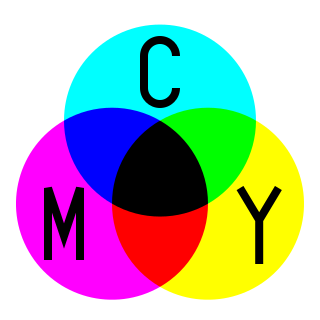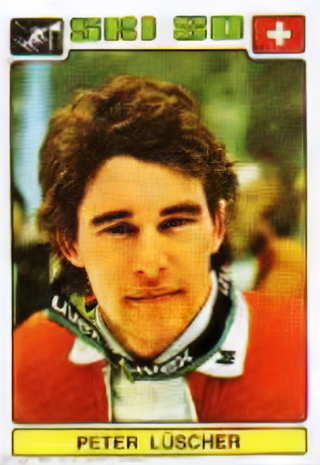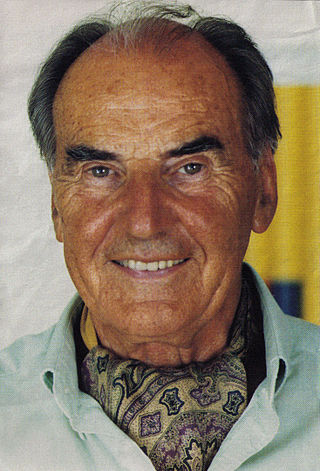See also
- Lüscher color test, a theory by Max Lüscher
Color theory are principles around the use of color in visual arts.
It may also refer to:

Color or colour is the visual perception based on the electromagnetic spectrum. Though color is not an inherent property of matter, color perception is related to an object's light absorption, reflection, emission spectra and interference. For most humans, colors are perceived in the visible light spectrum with three types of cone cells (trichromacy). Other animals may have a different number of cone cell types or have eyes sensitive to different wavelength, such as bees that can distinguish ultraviolet, and thus have a different color sensitivity range. Animal perception of color originates from different light wavelength or spectral sensitivity in cone cell types, which is then processed by the brain.
Neutral or neutrality may refer to:
Tone may refer to:
Component may refer to:
Value or values may refer to:
Color theory, or more specifically traditional color theory, is the historical body of knowledge describing the behavior of colors, namely in color mixing, color contrast effects, color harmony, color schemes and color symbolism. Modern color theory is generally referred to as Color science. While there is no clear distinction in scope, traditional color theory tends to be more subjective and have artistic applications, while color science tends to be more objective and have functional applications, such as in chemistry, astronomy or color reproduction. Color theory dates back at least as far as Aristotle's treatise On Colors. A formalization of "color theory" began in the 18th century, initially within a partisan controversy over Isaac Newton's theory of color and the nature of primary colors. By the end of the 19th century, a schism had formed between traditional color theory and color science.

This is an index of color topic-related articles.

Subtractive color or subtractive color mixing predicts the spectral power distribution of light after it passes through successive layers of partially absorbing media. This idealized model is the essential principle of how dyes and pigments are used in color printing and photography, where the perception of color is elicited after white light passes through microscopic "stacks" of partially absorbing media allowing some wavelengths of light to reach the eye and not others, and also in painting, whether the colors are mixed or applied in successive layers.

An afterimage is an image that continues to appear in the eyes after a period of exposure to the original image. An afterimage may be a normal phenomenon or may be pathological (palinopsia). Illusory palinopsia may be a pathological exaggeration of physiological afterimages. Afterimages occur because photochemical activity in the retina continues even when the eyes are no longer experiencing the original stimulus.
The Lüscher color test is a psychological test invented by Max Lüscher in Basel, Switzerland, first published in 1947 in German and first translated to English in 1969. The simplest form of the test instructs a subject to order a series of 8 colors in order of preference. This test claims that the order of preference can reveal characteristics of the subject's personality. The simplicity of the test has allowed it to be heavily tested.
Visual design elements and principles describe fundamental ideas about the practice of visual design.

Peter Lüscher is a former Swiss alpine ski racer who won an overall World Cup in 1979.

Max Lüscher was a Swiss psychotherapist known for inventing the Lüscher color test, a tool for measuring an individual's psychophysical state based on their color preferences. Besides research, teaching and practicing psychotherapy in Basel, Lüscher worked for international companies, amongst other things giving color advice. His book The Lüscher Test has been translated into more than 30 languages.

Color psychology is the study of hues as a determinant of human behavior. Color influences perceptions that are not obvious, such as the taste of food. Colors have qualities that can cause certain emotions in people. How color influences individuals may differ depending on age, gender, and culture. Although color associations can vary contextually between cultures, color preference is thought to be relatively uniform across gender and race.
Martin Lüscher is a Swiss theoretical physicist, who works primarily on numerical quantum chromodynamics.

In the psychology of color, color preferences are the tendency for an individual or a group to prefer some colors over others, such as having a favorite color or a traditional color.
Baker–Miller Pink, also known as P-618, Schauss pink, or Drunk-Tank Pink, is a tone of pink which has been observed to temporarily reduce hostile, violent or aggressive behavior. It was originally created by mixing white indoor latex paint with red trim semi-gloss outdoor paint in a 1:8 ratio by volume.

Jonas Lüscher is a Swiss-German writer and essayist.
Luscher or Lüscher is a surname. Notable people with the surname include:
Thomas F. Lüscher is a Swiss professor of cardiology, director of research, education and development and a consultant cardiologist at the Royal Brompton and Harefield NHS Foundation Trust and Imperial College London, and director of the Center for Molecular Cardiology at the University of Zurich.